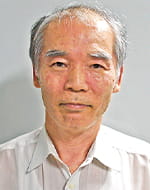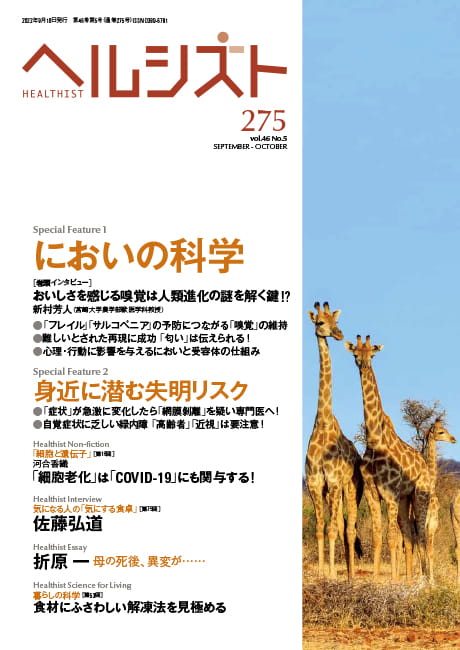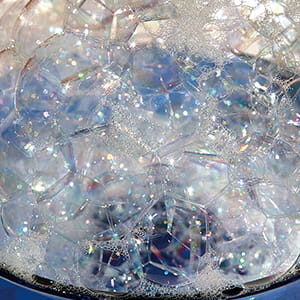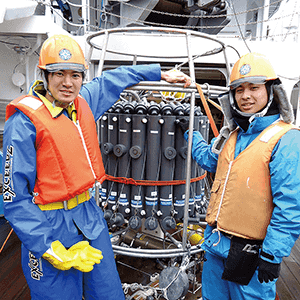How can we transmit smells? For example, the three primary colors of vision are the basic elements in reproducing colors, but given that we have around 400 types of olfactory receptors, there are no standards for what one might describe as “primary odors.” Accordingly, the reproduction of smells had been thought virtually impossible, but a way forward has at last become apparent. The first step is to make the odor components that will form the basis for a diverse array of smells by selecting and blending basic odor elements. It will reportedly be possible to reproduce smells remotely by combining these odor components in an “olfactory display.”
Special Feature 1 – The Science of Smell Achieving what was thought impossible: transmitting smells!
composition by Rie Iizuka
Smell is said to be the most difficult of the five senses to convey. In the case of auditory and visual sensations, we have already perfected technologies for turning their elements into electronic data for recording and reproduction, and such technologies are becoming more advanced by the day. For example, in the case of color, most people know how to alter the proportions of the three primary colors to achieve the color they desire.
Even with gustatory sensations, analysis has progressed to such an extent that we can replicate the taste of tuna from different ingredients. However, when it comes to smell and olfactory sensations, the reproduction of a smell based on certain principles has not been a common subject.
One factor behind this is the lack of anything that can serve as standards for smells. With our visual sense, we can basically replicate the primary colors as three distinct colors. However, given that we have approximately 400 olfactory receptors, there is nothing that could be described as a “primary odor.”
Odor components: similar to the three primary colors of vision
British biochemist John Amoore proposed the stereochemical theory of odor in the 1960s. Regarding the stereochemical structure of odor molecules as the key and olfactory receptors as the lock, Amoore took the approach of classifying similar molecular structures, based on the idea that it would ultimately be possible to define primary odors from these smells. However, as greater light was shed on receptors, including the discovery that the relationship between olfactory receptors and odor molecules was not one-to-one as in the case of light, the concept of primary odors in the olfactory sense ceased to be used. We are not looking to unravel the types of odor molecules.
Instead, we have devised a completely different technique to explore the elements of odor. Our technique involves analyzing numerous essential oils by means of mass spectrometry and then using the resulting measurements to construct odor components, in an effort to reproduce various smells. In this process, we do not focus on why a particular combination forms an odor component. It would be fair to describe our approach as having produced odors that are consistent from a data perspective.
We initially measured 185 different essential oils with a mass spectrometer to form the basis for replicating a diverse array of smells, equivalent to the three primary colors of vision. A mass spectrometer is a device that measures the mass of molecules and atoms, generating a mass spectrum that presents molecules ionized when the gas is discharged in order of size, based on the mass-to-charge ratio (Figure 1).

Figure 1. Sample data from mass spectrometryThis graph shows mass spectrum data obtained via mass spectrometry. The reproduced odor is designed in such a way that their mass spectrum is as close as possible to that of the original odor. Moreover, in determining the proportion of each odor component, their mass spectra should be as orthogonal as possible to each other without any negative values in the proportions.
A mass spectrum is generated from the vast amount of data obtained. A mass spectrum contains a great deal of information relating to the structure of the sample molecules and is effective in identifying known substances, for instance. We analyzed all this data and extracted 20 basis vectors. In this case, the basis vectors could also be described as combinations of the minimum vectors able to express all the vector information we obtained.
Using odor components to replicate smells
We then evaluated the basis vectors against 200 indicators and blended existing essential oils to approximate the patterns, creating 20 odor components (Figure 2). In searching for odor components, we found a number of hints for reproducing them. For instance, the odor in question could be more closely approximated when we altered the mixture of odor components in such a way that the vector of one odor component was as orthogonal as possible to the vectors of the other odor components.

Figure 2. Procedure for determining odor components with the aid of mass spectrometryThe mass spectra for numerous samples were measured and basis vectors were extracted from the data. The optimal number of odor components was determined at this stage. This involves comparing the data for a particular odor and classing those with similar patterns as the same, and those with differing patterns as different. For example, one might search for patterns similar to the pattern for an apple-like scent, to reproduce the scent of an apple.
In our technique based on mass spectrometry, our analysis does not examine such matters as which molecules in lavender constitute the aroma components and the content thereof. This kind of component analysis can be carried out with chromatography (a technique that involves separating substances to refine them and measure the quantity of a particular substance), but due to cost and other considerations, we do not currently use this approach. When adopting a chemistry-based approach to reproducing odors, the terms “molecule” and “compound” are often used. However, those of us in the field of engineering simply create odors that are consistent with the measured data, so chemistry researchers are often curious about what we do.
We regard odors in numerical terms. This enables us to use odor components derived from mass spectrometry data to efficiently reproduce a variety of odors.
The device that replicates and presents smells using these odor components is an olfactory display. Using a specific device to dispense, blend, atomize, and discharge odor components created using the aforementioned method makes it possible to reproduce an odor on the spot.
The latest olfactory displays use a micro dispenser (a device that sprays out a specified volume of liquid) to emit a tiny quantity of droplets, which are instantly atomized and give off a smell. The display is equipped with the same number of dispensers as odor components, each of which dispenses the components in the specified proportions (Figure 3).
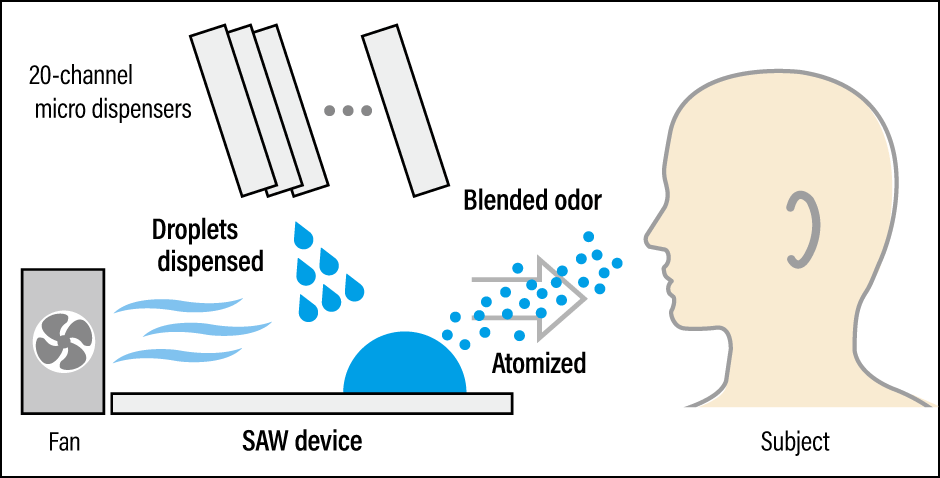
Figure 3. The olfactory display mechanismThe surface acoustic wave (SAW) device uses ultrasound to atomize and spray droplets of liquid. The solenoid valves serve as switches controlling whether or not an odor component is dispensed.
Wearable versions of olfactory displays are also on the increase. Attached beneath virtual reality (VR) goggles, they emit odors matching the scene on display.
The smell of roasting meat in a cooking scene
We are using 20 odor components in our studies, but even if we can achieve greater precision, it will become harder to design a device as the number of components increases. Accordingly, we are using an appropriate number of odor components, taking into account the need to achieve a good balance.
Devices that synthesize and emit components were already in existence, but the conventional method had a number of issues, as it involved blending aromas at the liquid level, which meant that presenting them took time and the odor components were quickly used up. The olfactory display we have developed provides a solution to these issues.
We are considering the application of this display in an array of settings, including entertainment. Let us look at a specific scenario.
Collaborations with movies are one area where odor reproduction is a frequently discussed topic. The most striking project in which we have been involved was an experiment centered on the movie Sen to Chihiro no Kamikakushi (Spirited Away). The film itself lasts about two hours, but we edited it down to just four minutes and experimented with dispensing relevant odors when various scenes were shown on the screen, such as the smell of roasting meat during a cooking scene. We then distributed a questionnaire to the people who participated in the screening, asking them which scenes they had found most striking. The results were highly interesting.
The movie features a character called the Stink Spirit, which emits a pungent stench; for the scene in which the Stink Spirit first appears, we dispensed a putrid odor, and in the next scene, which featured the Stink Spirit bathing in a medicinal bath, we dispensed a herbal scent. These scenes had left the biggest impression on almost all the participants. Thus, one can see that the way in which people enjoy movies changes when the element of smell is added, compared to viewing a film without added odors.
We also create various games. There is a cooking game that generates sound and smell as the player goes through the steps in cooking a curry. The ingredients make a sizzling sound when the player places them in the saucepan. Then the smells begin to emerge: first, the smell of roasting meat, which changes to the smell of curry when the player puts the curry roux in the pan.
For our Virtual Ice Cream Shop, we have prepared 13 scents (Figure 4). The user can try a mixture of flavors by sliding a bar on the computer to blend each flavor in their preferred proportion.
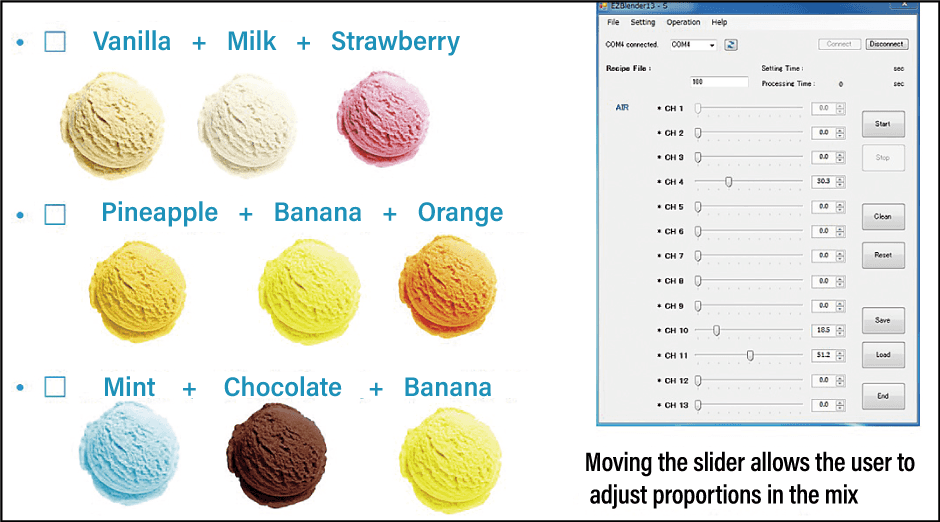
Figure 4. Virtual Ice Cream Shop screenThe user chooses the flavor they wish to eat on the computer and their desired flavor is blended, allowing them to “taste” it on the spot.
Smell is closely related to taste. Accordingly, we undertook a virtual beverage experiment (Figure 5). We prepared various sugar-free beverages and dispensed scents when the user was drinking their beverage, with the result that the beverage seemed sweet to the user. As the drinks —— which included sugar-free coffee and sugar-free soda —— contained no sugar or any other sweet constituents, they were not actually sweet. The olfactory display merely dispenses scents such as vanilla and milk, making sugar-free coffee seem sweet, even though the subject knows that the beverage contains no sweet constituents.
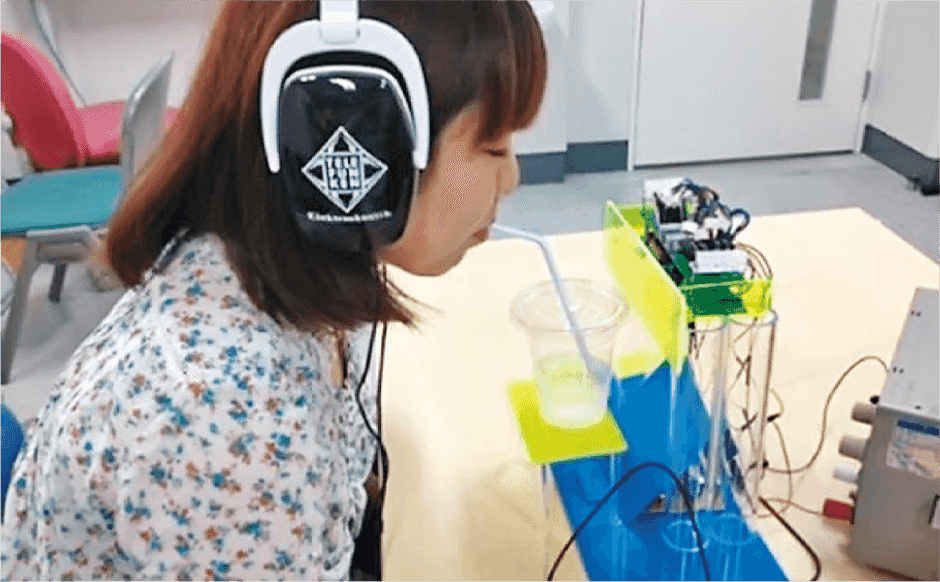
Figure 5. Virtual beverage experienceThe clear, non-sweet, sugar-free soda seems sweet when the olfactory display discharges scents such as vanilla.
There are conflicting theories about whether this would be effective in helping people to cut back on sugar or whether it might conversely increase the desire for sugar because the individual has not actually consumed any. Whatever the case, we believe the device might be effective in complementing the sense of taste.
In the world of games, efforts are underway to combine this technology with head-mounted displays and other wearable devices. We created a game scenario in which the player navigates a maze to find a cocktail bar in the middle. The player cannot pass through the walls of the maze. However, there is a mechanism enabling the player to pass through pillars marked with an illustration of a particular fruit, such as an orange, and in the instant they do so, the scent of that fruit is dispensed (Figure 6). I believe this made the experience feel more real to the subjects.
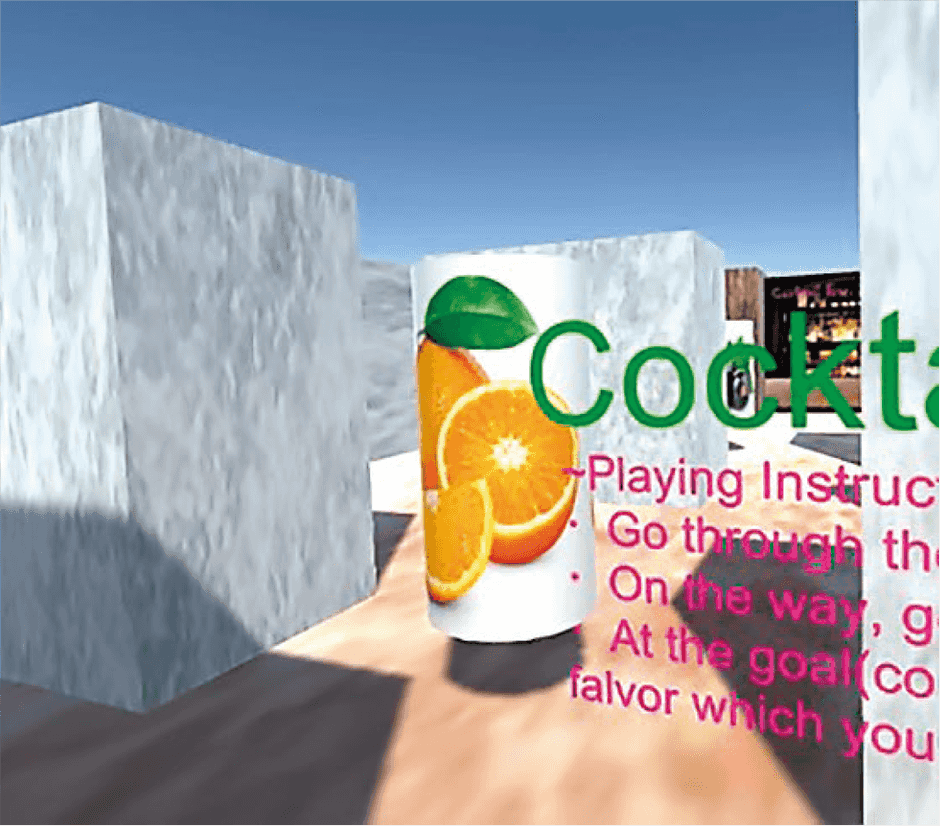
Figure 6. Maze gameThe player can only pass through pillars bearing illustrations of fruit and the scent of that fruit is emitted when they pass through one.
We are also creating a disaster drill simulator. Based on the scenario of a small fire breaking out somewhere in a two-story house, the user has to follow the smell of smoke to find the site of the fire. Factors such as the smell’s intensity and the way it spreads are calculated using a technique called computational fluid dynamics simulation.
Could also be applied to disaster drills and medical care
This method has made it possible to reproduce certain odors; in the future, I believe we will be able to transmit smells remotely in conjunction with information and communications technology (ICT).
We have been working on what is referred to as “teleolfaction” for some time. In a more primitive experiment, we have already succeeded in transmitting smells to a remote site with the aid of sensors (Figure 7).

Figure 7. Transmitting an odor to a remote siteThe odor is transmitted to a remote location with the aid of sensors and an olfactory display. A total of 13 odor components were used on this occasion. This means that they theoretically could reproduce 4,096 odors.
An apple, pineapple, and other fruit are placed on a remotely controlled turntable along with fragrances resembling their scents. The turntable is equipped with odor sensors and an olfactory display is installed near the subject at the remote location. The apparatus is set up so that, when the subject remotely moves the turntable to their desired position and presses a switch, the odor sensor detects the fragrance and the olfactory display near the subject emits that scent, enabling the subject to smell it.
In other words, we have succeeded to some extent in remotely delivering odors. If olfactory displays come to be fitted to most computers, I believe it might become possible in the not-too-distant future to create a website that smells of roses.
In addition to popularizing olfactory displays, bringing olfactory ICT to fruition will likely require the construction of scent libraries. A scent library contains a record of the proportions of each odor component required to create an odor and will be essential in order to instantly generate a diverse array of odors when operated via a computer. If we can build scent libraries, attaching smells to various contents and tools will become easy.
We know that smells have a great influence on human moods and emotions, and I believe the scope of their application will broaden further in the future. While we are now at the stage where olfactory displays can be used to reproduce odors, we will need to build up a range of applications. Initiatives focused on the reproduction of smells inevitably tend to involve the fields of food and entertainment, but as shown above, there are also hopes that this technology could also spread to disaster drill simulators and medical applications.
In addition, reproducing odors is not the goal. We are also working on research into creating odors from verbal information. It would be the olfactory equivalent of telling a smart speaker, “Play some soothing music.” As such, if the user said, “Create a fresh smell,” the device would generate a scent that it interpreted as fresh. Accumulating data will give us a powerful tool for interpreting things expressed verbally in this way. Efforts to reproduce the world of smell are growing increasingly extensive.


